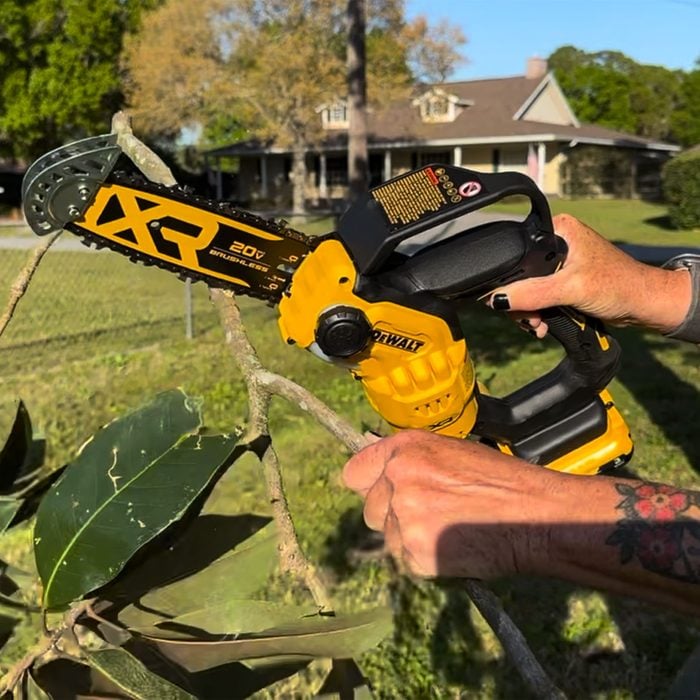
Best Overall Mini Chainsaw
Dewalt Cordless Battery Powered Chainsaw
Pros:
- High-quality brand
- Lightweight
- 3-year warranty
- Ships with oil
- Versatile battery packs
Cons:
- Pricey
The Dewalt Mini Chainsaw was one of two that shipped with bar and chain oil. This was one of the first things I noticed upon unpackaging it, and it was indeed a welcome accessory. As with most of the saws, it required virtually nothing to get up and running. The device has the usual black and yellow Dewalt styling and uses 20v batteries that are common across many Dewalt tools such as drills, drivers, and saws.
It shipped with a 20V three-amp-hour battery, which was plenty of power to cut through everything I planned to trim in my yard (which is about an acre). Had I planned on taking down all the invasive Austrian pines to a length that my fire pit could handle, I definitely would have run out of juice. Still, overall, the three-amp-hour battery did the trick, and the 20V was plenty of power to cut through four- to six-inch diameter fruit and pine trees.
The brushless motor ran quietly, and the device, which weighed about 5 pounds with the battery attached, was light enough to work with for extended periods. A tool is required to adjust the chain tension, but the tool is included and stored on the device.
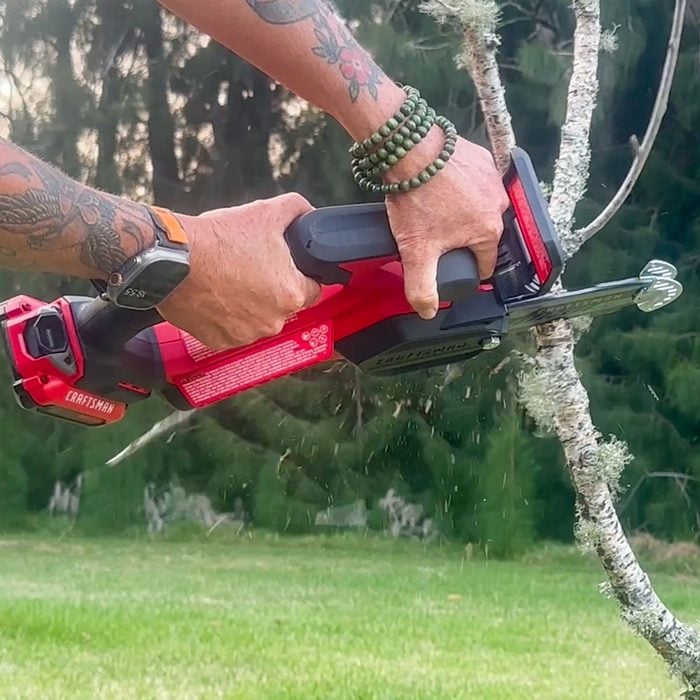
Best Budget Mini Chainsaw
Craftsman Battery Pruning Saw Kit
Pros:
- Affordable option
- Battery charger is very compact
- Lightweight and easy to use
- Integrated tip guard
Cons:
- No chain oiler
The Craftsman is yet another 20V mini chain saw, which seems to be the standard voltage in the mini chain saw world. The first thing that sets it apart is the accessible price, which is why I named this the best budget saw. I was pleased with how lightweight and easy it was to use (not to mention practical).
This chainsaw contains a guard at the tip meant to protect against kickbacks. There’s no doubt that it would work. Though the blade is short, there is a handle at the front of the saw for your less dominate hand. In my case, I gripped the handle with my right hand and the second holding area with my left hand, which was conveniently located behind yet another safety feature of a hand guard.
A metal clip is on the tool, designed to hang the saw on a proprietary track system, but I could see using it to attach to a tool belt. The chain must be tensioned with a tool that resides on the saw. After tensioning the chain, I made approximately 20 cuts with the saw, and the chain was still perfectly tensioned.
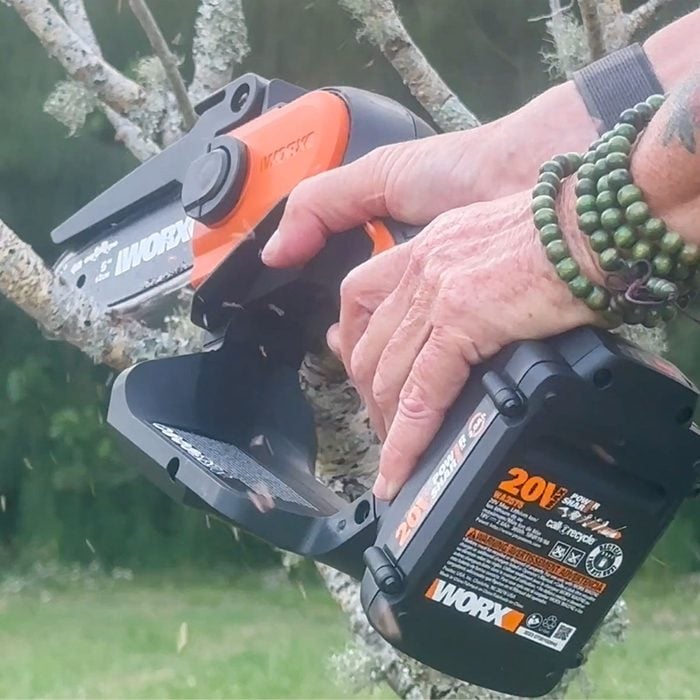
Best Compact Mini Chainsaw
Worx 20V Mini Chainsaw
Pros:
- Compact for tight spaces
- One-handed design
- No tool required to remove case
- Lightweight
Cons:
- Only cuts small diameter limbs
The Worx saw is another 20V machine with a small but capable five-inch bar. It’s compact enough to be operated with one hand. It doesn’t have a kickback guard but employs a type of hand guard that looks like something you see over a circular saw blade on a table saw.
It has an onboard chain tensioning tool, and the saw cover can be removed without a tool to get to the chain. The saw is super lightweight, and I could carry it around with one hand without tiring. It shipped with a small container to put the oil in, but no chain oil came with the device. Getting the bar and chain oil into the small container proved to be challenging, but once completed, it was a done deal. Instead of using an automatic bar chain oiler, you run the bar chain oil along the chain using the oil “squirt” bottle, like you might oil a bicycle chain.
Once I had the chain oiled, I was off and running. Since I could easily hold the saw with one hand, it worked great for getting into the nooks and crannies of fruit trees to trim small branches. Despite the small bar size, I was still able to go through three-inch diameter limbs with ease.
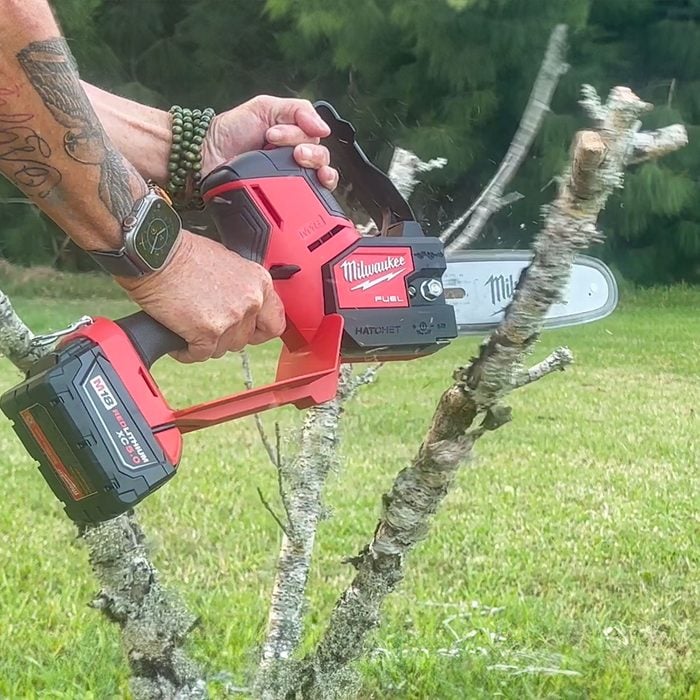
Best Staying Power
Milwaukee 18V Mini Chainsaw
Pros:
- Battery compatibility with hand tools
- Large cutting capacity
- Lengthy run time
- Lanyard attachment
Cons:
- Heavy
The Milwaukee mini chainsaw is unique in this lineup in that it utilizes an 18V battery. You won’t see a big power difference from the 20V saws, but you will immediately notice the long run-time (thanks to a 5amp hour battery) coupled with the large eight-inch blade. The only downside to this long-running battery is its size, which adds some weight to the equipment.
The Milwaukee brand means that you can use this battery with a multitude of the manufacturer’s hand tools like drills and drivers. It has clip to attach to a tool belt and an automatic oiler. It has no kickback guard, but does have a hand guard for protection.
I used the traditional onboard tool to open the case, tension the chain and test the saw. It ripped through small branches and easily felled a dead fruit tree with about a six-inch diameter. After making a boatload of cuts to pare down pine branches, the battery still had a full charge.
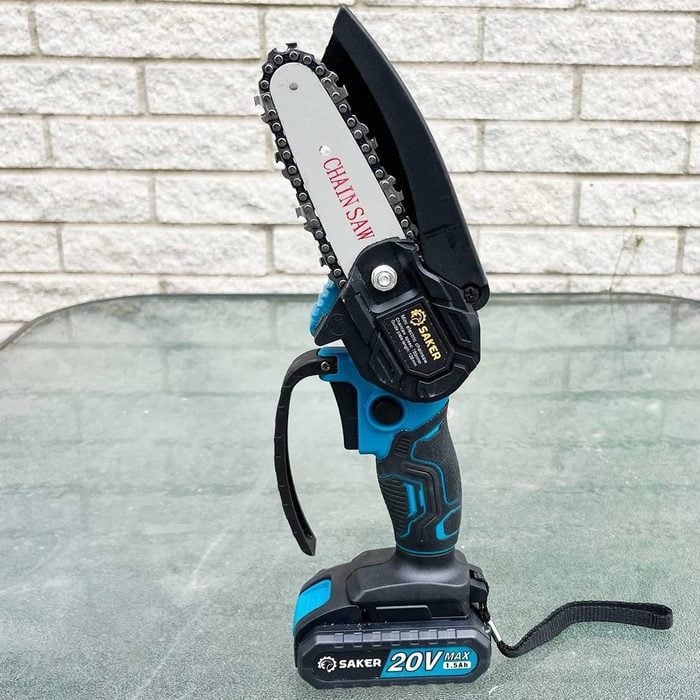
Best Mini Chainsaw for Tight Spaces
Saker 20V Mini Chainsaw
Pros:
- Gets into tight places
- Lightweight
- Ships with Oil
- Lanyard
Cons:
- Small cutting diameter
The Saker mini chainsaw comes out of the box with oil, an oil container, and a tool to adjust the chain tension. It’s the smallest and lightest of the mini chain saws we tested and even has a lanyard you can wrap around your wrist.
It ships with a 20V 1.5 amp-hour battery, which might not sound like much, but is a perfect match for the size of this saw and its intended uses. After an hour of intermittent use, the battery still had 75% power. The 20V of power was of course enough to handle any sawing job.
The saw ran quietly and sliced through both green and dead wood. There was minimal vibration and mind you, all this sawing was done one-handed using the cushioned grip. There was virtually no fatigue after paring down a large pile of branches and it excelled at getting into the tight spots due to it’s diminutive size.
What to Look for When Buying a Mini Chainsaw
You have several things to consider when purchasing a mini chainsaw. First and foremost, if you already own a battery-powered tool with an interchangeable battery, then you may want to start your search within the brand to avoid having more chargers. If you don’t already have a suitable battery pack or you don’t see a mini chainsaw made by the manufacturer that meets your needs or budget, then consider the following:
Ask yourself how often you plan on using the mini chainsaw. You may want to use it just for pruning once or twice a year and to clean up debris after wind, rain, and snow storms. If that’s the case, then you may want a tool that has an extended run time, so you can complete large tasks in one swoop.
It’s pertinent to try to imagine the largest diameter limb you may need to trim. If you don’t have a larger saw capable of cutting large branches, then you’ll want to consider getting the longest bar you can manage and afford.
Speaking of managing the mini chainsaw, your ability to handle the tool is another factor to consider. Some of the tools are lighter and smaller, and therefore easier to use for extended periods. The larger saws offer two-handed holds, which offer stability but require a little extra effort.
Additionally, consider your comfort level with a mini chainsaw. Heavier and larger saws may pose more risk. However, many of the saws come with safety precautions such as anti-kickback guards and hand protectors.
Why You Should Trust Us
The testers and product reviewers at Family Handyman have been hard at work developing standardized testing procedures for products in order to ensure that we deliver consistent and accurate product reviews.
I personally developed the testing procedures for both full-sized gasoline powered chainsaws as well as battery-powered mini chainsaws. Having owned a landscaping company as well as having decades of experience managing my personal, heavily tree-laden properties, I’ve had my hands on a multitude of saws and know what to look for.
As a professional tester of all things that one can test (products, software, and maybe even patience), I take my role seriously and aim to deliver honest, thoughtful, and conscientious reviews.
Mini Chainsaws Tested Side-by-Side
We set out to find the best mini chainsaws at all ends of the size spectrum, which happens to be about five to eight inches (on average) with some bigger and smaller sizes. We ended up selecting five of our favorites for this round-up, believing that each saw filled a certain need.
Users needs are unique, so we also tested saws of various weights. Lastly, budget is a concern for nearly everyone, so we sourced mini chainsaws ranging from under $100 to over $250 and as always, considered brand credibility.
How We Sawed Our Way Through the Mini Chainsaw Tests
The first thing we took into account when reviewing mini chain saws was the packaging and how easy it was get started. Each saw we tested came with a battery and charger. All of the saws also came fully assembled, which was a nice bonus. However, only one saw shipped with bar and chain oil, which is a must-have before you can begin using your saw.
We also looked at safety features. As I mentioned, some saws employ a type of hand guard while others had anti-kickback tips, which are excellent safety measures. All of the saws tested required pressing two starting mechanisms in order to run and came with chain guards during storage.
FAQ
What is the difference between a chainsaw and a pruning chainsaw or mini chainsaw?
Essentially, it comes down to the size and weight when differentiating between a chainsaw and a pruning chainsaw. Most mini chainsaws/pruners are battery operated, whereas most regular chainsaws are gas- or battery-powered.
Are electric pruning saws any good?
You bet they are! Pruning saws tackle projects that traditionally require a lot of elbow grease. Projects that normally must be done with hand saws, shears, and loppers can all be done with electric pruning saws. The battery-powered models require almost no maintenance other than sharpening and are reliable.
Can you prune with a chainsaw?
Absolutely. There is some vibration that you’ll experience when going after twigs and sticks but they still get the job done. They really excel at trimming small, low-hanging branches.


